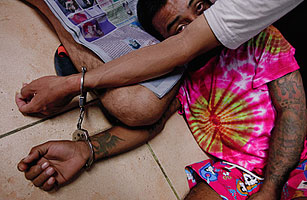
It is easy to miss the spirit gate that guards the entrance to Phiyer, a remote village in northern Laos. Half submerged in weeds beside a field of towering sugarcane, the simple wooden structure resembles a set of miniature rustic goalposts. Look closely, however, and you will notice it is strung with roughly carved swords and assault rifles made of bamboo. The villagers believe the gate wards off disease and evil spirits.
A modern epidemic now threatens Phiyer and no amount of ancient voodoo will protect it. The village lies in the mountainous Sing district, which shares its northern border — and the mighty Mekong River — with Burma. There, in semiautonomous fiefdoms ruled by heavily armed militias, secret factories spew out hundreds of millions of tablets of methamphetamine, a highly addictive drug better known there by its Thai name yaba . From Burma, the drug is spirited across the ill-policed Mekong into Laos and its four other neighbors — China, Thailand, Vietnam and Cambodia — and onward to other parts of Asia and as far afield as New Zealand. Sleepy Phiyer sits on one of Asia’s — and the world’s — busiest drug-trafficking routes.
Northern Laos was once notorious for opium, and its derivative, heroin. Together with Thailand and Burma, this mountainous region makes up the Golden Triangle, which once provided at least half of the world’s opium supply. Burma alone produced nearly 1,800 metric tons in 1993, estimates the U.N. Office on Drugs and Crime . A decade later, after eradication programs in all three countries, opium production in Southeast Asia fell to about 350 metric tons. Factor in global trends — soaring opium production in Afghanistan, or Colombia’s once growing share of the U.S. heroin market — and the Golden Triangle’s days as the world’s biggest opiate factory seemed numbered.
But the Golden Triangle — probably named after the gold once traded for opium — didn’t die. It did what any good business does in our globalized age: expand its markets and diversify its product range. First, new customers were found for an old product: heroin that once moved south into Thailand, and then on to international markets, now primarily moves north into China, where 2.2 million users consumed 45 metric tons of mostly Burmese heroin in 2008, says the UNODC. Second, the Golden Triangle was by the late 1990s manufacturing the product that symbolizes its renaissance. Methamphetamine is Asia’s favorite high. Its popularity is a symptom of the region’s astonishing economic growth. This new prosperity has liberalized trade, reduced transportation costs, accelerated the movement of people and products, and created a vast middle class with cash to burn. All this has helped traffickers shift their product to millions of fresh consumers.
Methamphetamine can be eaten, smoked, snorted or injected. It boosts energy, self-esteem and sexual pleasure, but can also cause paranoia and aggression. It is highly addictive: withdrawal symptoms include fatigue, anxiety and long-term depression. That addiction is difficult to treat, partly because the drug’s popularity straddles social and economic divides, town and country, work and leisure. The same drug that helps laborers endure backbreaking work in the fields allows affluent urbanites to party till dawn.